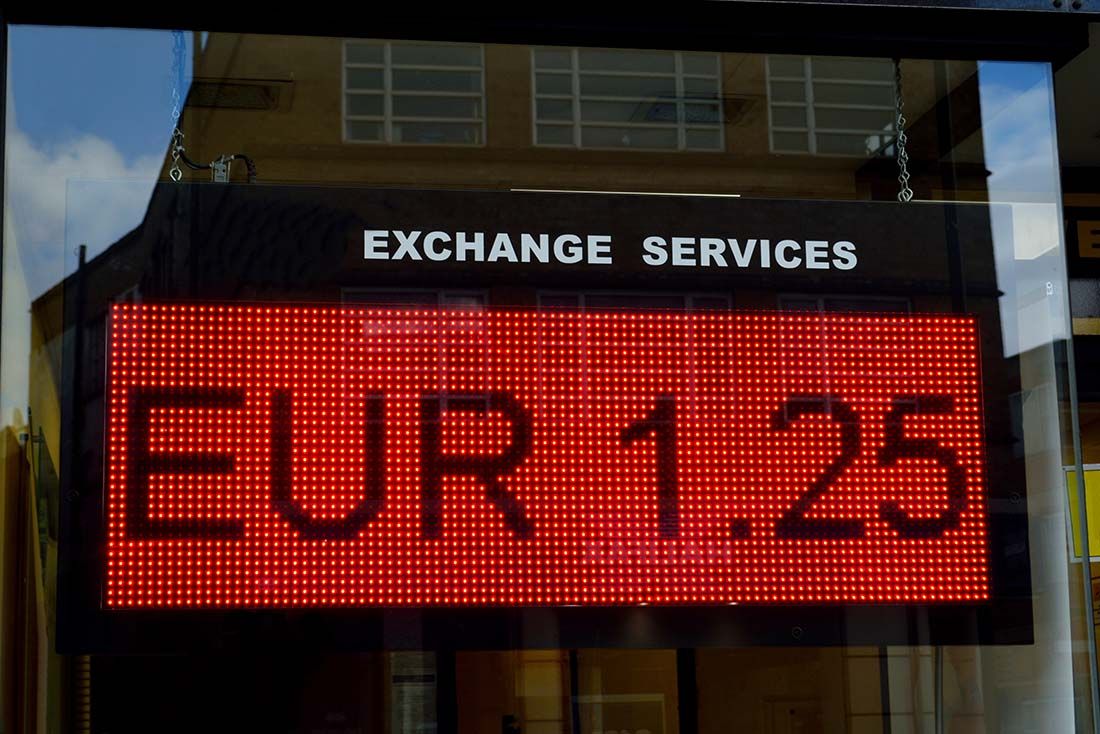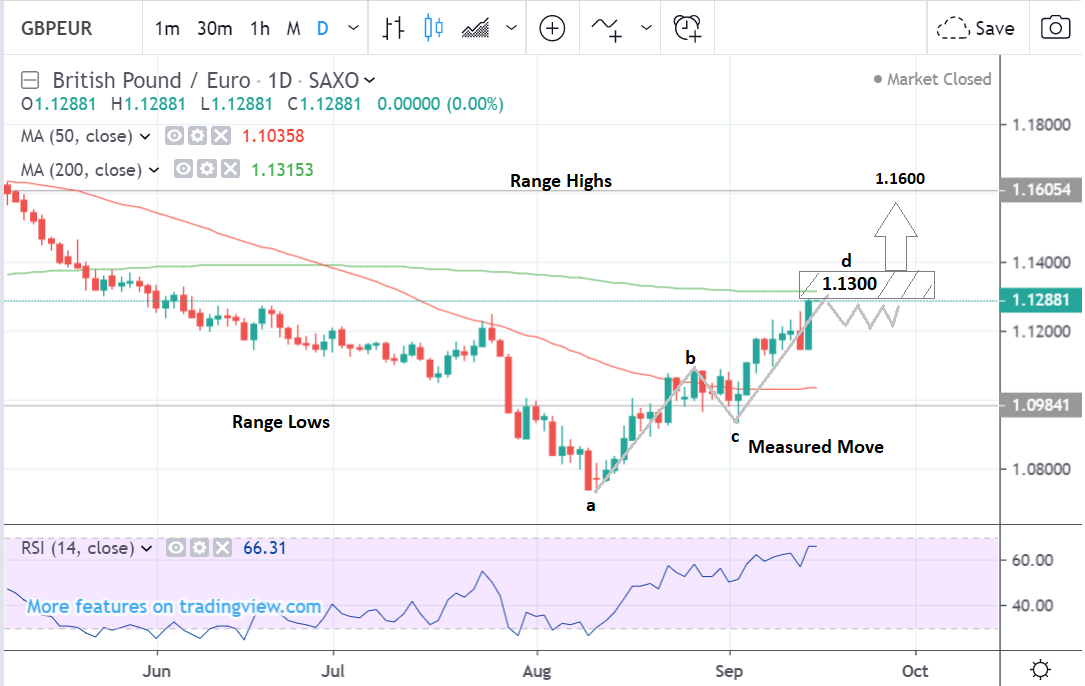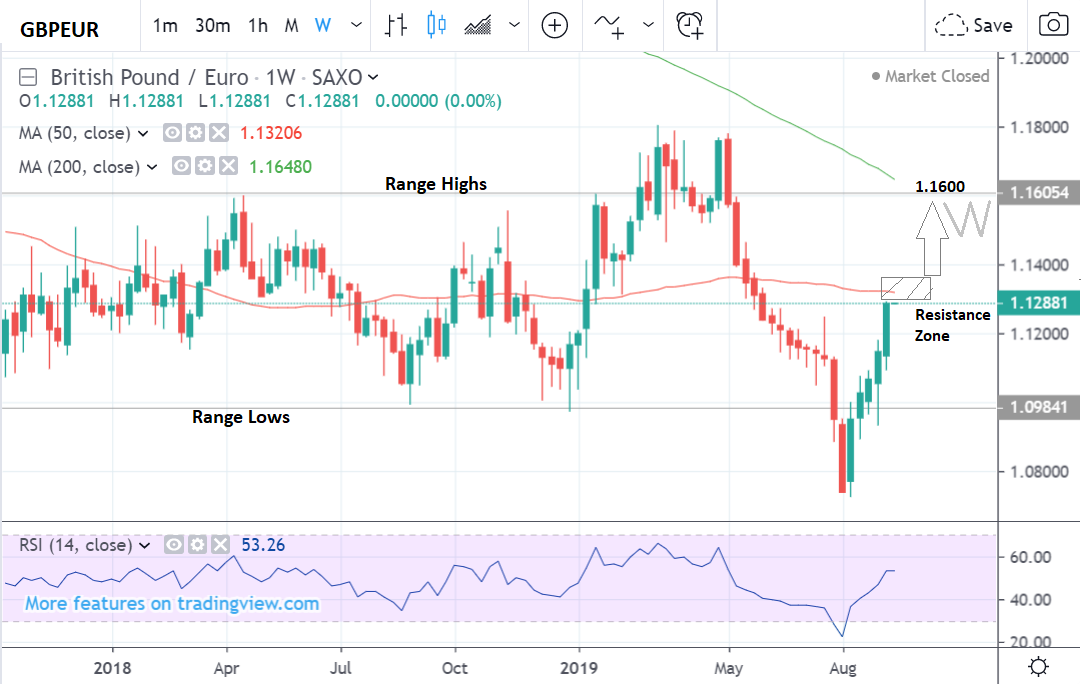The Pound-to-Euro Rate in the Week Ahead: Uptrend Runs Head-on Into Resistance on Charts

Image © Adobe Images
- GBP/EUR runs head-on into resistance zone on charts.
- Temporary pull-back now likely before upside resumes.
- Pound to be driven by Brexit news; Euro by ZEW survey.
The Pound-to-Euro rate is set to begin trading around 1.1288 at the beginning of the new week after closing the previous one around 1.28% higher on Friday, and studies of the charts indicate that tough resistance up ahead may cause a temporary pullback in the pair.
The 4 hour chart, used to determine the short-term outlook over the coming week, shows the pair in a steady uptrend that is approaching a tough resistance zone stretching from 1.1297 to 1.1321.
This zone is made up of major moving averages and a price target. It is likely to present a tough obstacle to further upside so there is a good chance the pair will recoil on first touching the zone, likely falling back to the lower 1.12 area.
However, the market is expected to eventually break above the zone and continue rising in line with the established short-term uptrend. Such a break would be confirmed by a move above 1.1350 and could see the pair rise to around the 1.1500 level.
.png)
Above: Pound-to-Euro rate shown at 4-hour intervals.
The daily chart shows how the pair has risen in a price pattern called a ‘measured move’ since the August 11 lows. The pattern is near completion and will probably be followed by a corrective phase in which it consolidates in a range before beginning a new up move.
A break above the 1.1350 highs would provide the confirmatory green-light to more upside, likley extending to a target of 1.1600 in the medium-term and the top of a multi-year range.
The RSI momentum indicator in the lower panel is close to the overbought zone above 70 and is further evidence supporting the idea of a pullback before going higher. The daily chart is used to analyse the medium-term trend, which is the next week to month of price action.

Above: Pound-to-Euro rate shown at daily intervals.
The weekly chart shows the pair has upside potential all the way to the range highs at 1.1600, at which point it is likely to struggle. The chart is used to analyse the long-term trend, which is defined as the next several months. The RSI momentum indicator is rising quite steeply, suggesting more upside.

Above: Pound-to-Euro rate shown at weekly intervals.
AA
The Pound: What to Watch
Brexit will probably continue to be the main driver of the Pound in the coming week despite high profile events like the Bank of England (BOE) interest rate decision on Thursday, inflation data on Wednesday and retail sales Thursday.
The UK government’s progress towards agreeing a Brexit deal with the EU before the October 31 deadline is likely to take centre stage, with the main focus on finding a solution which maintains a frictionless border with Ireland after Brexit so as to maintain the integrity of the Good Friday agreement.
It is said the government is considering a variety of different options in this regard, including placing a border down the Irish sea with Northern and Southern Ireland having greater regulatory alignment. This would especially be the case in the ‘agri-food’ and electricity sectors where the whole island is already heavily integrated as one.
Rumours of a breakthrough helped the Pound storm to new highs last week and there is a risk the same might happen in the week ahead. Recent surprisingly strong data has eased concerns the UK might be entering a recession but economic figures are likely to play only a minor role in the Pound’s trajectory. The BOE meeting on Thursday is also unlikely to cause volatility since the bank will probably not alter its policy until after the Brexit process.
“We are not going to get that (a change in policy) from the BOE,” says Raffi Boyadijian, a strategist at XM.com. “They have so far stood by their slight tightening bias; and given the expected extension to the Brexit deadline, which we are likely to get out to the end of January next year - unless we get a Brexit deal - and the easing risks of a UK recession, after recent UK data has surprised to the upside, there is no risk of an imminent recession in the UK."
AA
The Euro: What to Watch
The main market-moving releases for the Euro in the week ahead are the ZEW sentiment index on Tuesday and inflation figures out on Wednesday.
The ZEW is an influential survey compiled from interviews with professional investors and is considered a good indicator of changes in the broader economy so it can often impact the Euro. The ZEW for September is forecast to rise to -38 in Germany, from -44.1 previously, when released at 10.00 on Tuesday.
The reported figure is the balance of optimistic and pessimistic survey responses, and both the German and the Europe-wide gauges are significant to the market. A better-than-expected improvement in sentiment would probably support the Euro and vice versa for the worse-than-expected deterioration.
The other key release is CPI although this is the second estimate of August CPI, rather than the more important preliminary or 'flash' estimate released at the start of each month. Headline inflation fell back to 1% this month and core inflation declined to 0.9%.
Both headline and core inflation figures are expected to be confirmed by this week's 'final' numbers. However, there is also a possibility the numbers are revised higher given the extent they've fallen recently, an outcome which would be positive for the Euro.
Time to move your money? Get 3-5% more currency than your bank would offer by using the services of foreign exchange specialists at RationalFX. A specialist broker can deliver you an exchange rate closer to the real market rate, thereby saving you substantial quantities of currency. Find out more here.
* Advertisement




